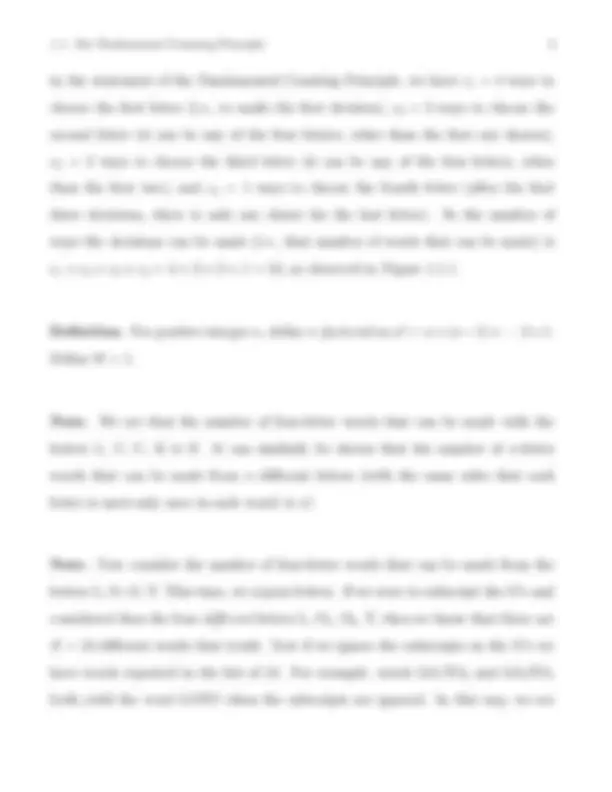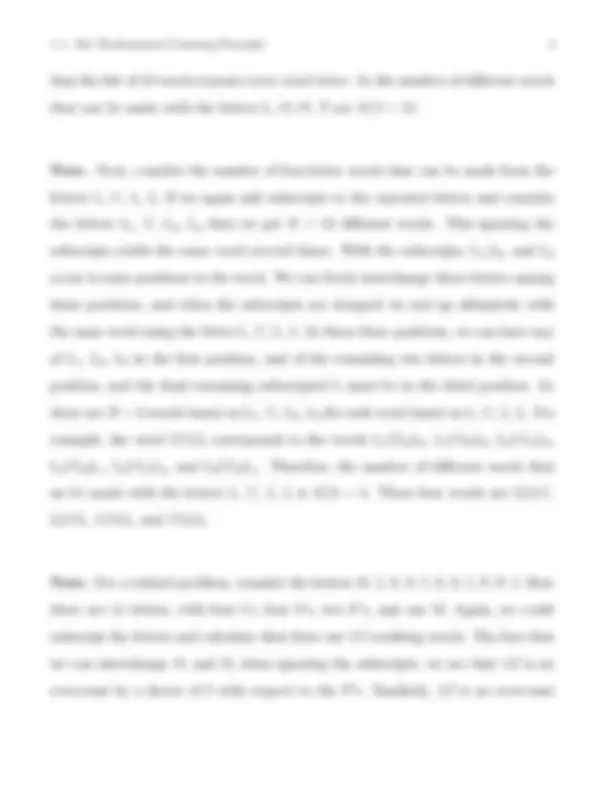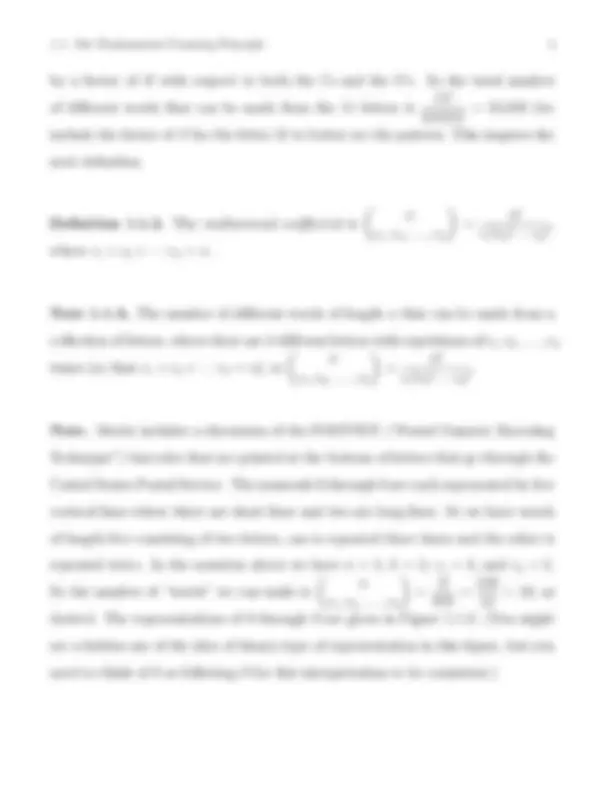





Study with the several resources on Docsity

Earn points by helping other students or get them with a premium plan


Prepare for your exams
Study with the several resources on Docsity

Earn points to download
Earn points by helping other students or get them with a premium plan
Community
Ask the community for help and clear up your study doubts
Discover the best universities in your country according to Docsity users
Free resources
Download our free guides on studying techniques, anxiety management strategies, and thesis advice from Docsity tutors
The Fundamental Counting Principle, a fundamental concept in combinatorics that helps count the number of ways to make a sequence of decisions when the number of choices for each decision is independent of previous decisions. examples of applying the principle to count the number of different four-letter words that can be made using specific letters, and explains how to calculate the multinomial coefficient to find the number of words of a given length made from a collection of letters with repetitions. The document also discusses the use of the Fundamental Counting Principle in finding the number of divisors of a positive integer.
What you will learn
Typology: Schemes and Mind Maps
1 / 7

This page cannot be seen from the preview
Don't miss anything!




Note. According to ETSU’s own Dr. Robert Beeler, “Put simply, combinatorics is the mathematics of counting.” This is the first sentence in the first section of his How to Count: An Introduction to Combinatorics and Its Applications (Springer, 2015). In this section, we state and apply the Fundamental Counting Principle. We will use this idea throughout the course (so often that, after some experience, we will not even reference it).
Note. You will encounter the Fundamental Counting Principle in several of your other classes. For example, you are likely to see it in:
Foundations of Probability and Statistics-Calculus Based (MATH 2050). See my online notes for this class on Section 2.2. Counting Methods,
Mathematical Reasoning (MATH 3000). See my online notes on Section 4.1. Cardinality; Fundamental Counting Principles (notice Theorem 4.7 which ex- presses the counting principle in terms of the size of a Cartesian product of sets),
Graduate Level Combinatorics. This is not an official ETSU class (but easily could be). See my notes on Section 1.1. The Sum and Product Rules for Sets (notice Lemma 1.1.1(b) where, again, the counting principle is stated in terms of Cartesian products; the Fundamental Counting Principle called the “Product Rule” in this setting).
Note. The Fundamental Counting Principle states: Consider a (finite) sequence of decisions. Suppose the number of choices for each individual decision is independent of decisions made previously in the sequence. Then the number of ways to make the whole sequence of decisions is the product of these numbers of choices. Symbolically, suppose ci is the number of choices for decision i, where 1 ≤ i < n. Assuming the number of choices ci+1 does not depend on the previous choices made for 1, 2 ,... , i, then the number of different ways to make the sequence of decisions is c 1 × c 2 × · · · × cn.
Note. Consider the letters L, U, C, K. We can use the Fundamental Counting Principle to count the number of different four-letter words we can make by using these letters (each one exactly once in a word). By making an exhaustive list, we see that there are 24 possible words; see Figure 1.1.1.
Note. We now apply the Fundamental Counting Principle to the number of of words one can make from letters L, U, C, K. There are four decisions to be made: (1) decide on the first letter, (2) decide on the second letter, (3) decide on the third letter, and (4) decide on the fourth letter. With the ci notation mentioned
that the list of 24 words repeats every word twice. So the number of different words that can be made with the letters L, O, O, T are 4!/2 = 12.
Note. Next, consider the number of four-letter words that can be made from the letters L, U, L, L. If we again add subscripts to the repeated letters and consider the letters L 1 , U, L 2 , L 3 then we get 4! = 24 different words. This ignoring the subscripts yields the same word several times. With the subscripts, L 1 ,L 2 , and L 3 occur is some positions in the word. We can freely interchange these letters among these positions, and when the subscripts are dropped we end up ultimately with the same word using the letter L, U, L, L. In these three positions, we can have any of L 1 , L 2 , L 3 in the first position, and of the remaining two letters in the second position, and the final remaining subscripted L must be in the third position. So there are 3! = 6 words based on L 1 , U, L 2 , L 3 for each word based on L, U, L, L. For example, the word LULL corresponds to the words L 1 UL 2 L 3 , L 1 UL 3 L 2 , L 2 UL 1 L 3 , L 2 UL 3 L 1 , L 3 UL 1 L 2 , and L 3 UL 2 L 1. Therefore, the number of different words that an be made with the letters L, U, L, L is 4!/6 = 4. These four words are LLLU, LLUL, LULL, and ULLL.
Note. For a related problem, consider the letters M, I, S, S, I, S, S, I, P, P, I. Here there are 11 letters, with four I’s, four S’s, two P’s, and one M. Again, we could subscript the letters and calculate that there are 11! resulting words. The fact that we can interchange P 1 and P 2 when ignoring the subscripts, we see that 11! is an overcount by a factor of 2 with respect to the P’s. Similarly, 11! is an overcount
by a factor of 4! with respect to both the I’s and the S’s. So the total number of different words that can be made from the 11 letters is (^) 4!4!2!1! 11! = 34,650 (we include the factor of 1! for the letter M to better see the pattern. This inspires the next definition.
Definition 1.1.2. The multinomial coefficient is
( (^) n r 1 , r 2 ,... , rk
= (^) r 1 !r 2 !n · · ·! rk!, where r 1 + r 2 + · · · rk = n.
Note 1.1.A. The number of different words of length n that can be made from a collection of letters, where there are k different letters with repetitions of r 1 , r 2 ,... , rk times (so that r 1 + r 2 + · · · rk = n), is
( (^) n r 1 , r 2 ,... , rk
= (^) r 1 !r 2 !n · · ·! rk!.
Note. Merris includes a discussion of the POSTNET (“Postal Numeric Encoding Technique”) barcodes that are printed at the bottom of letters that go through the United States Postal Service. The numerals 0 through 9 are each represented by five vertical lines where three are short lines and two are long lines. So we have words of length five consisting of two letters, one is repeated three times and the other is repeated twice. In the notation above we have n = 5, k = 2, r 1 = 3, and r 2 = 2. So the number of “words” we can make is
( (^) n r 1 , r 2 ,... , rk
= (^) 3!2! 5! =^12012 = 10, as desired. The representations of 0 through 9 are given in Figure 1.1.3. (You might see a hidden use of the idea of binary-type of representation in this figure, but you need to think of 0 as following 9 for this interpretation to be consistent.)
then we can use this factorization and the Fundamental Counting Principle to find the number of divisors of the positive integer. For example, for n = 360 we have 360 = 2^3 × 32 × 5. If d is a divisor of 360, then by the Fundamental Theorem of Arithmetic we must have d = 2a^ × 3 b^ × 5 c^ where 0 ≤ a ≤ 3, 0 ≤ b ≤ 2, and 0 ≤ c ≤ 1. So to get a divisor, we choose the exponents a, b, c. There are four choices for a, three choices for b, and two choices for c. Hence, by the Fundamental Counting Principle there are 4 × 3 × 2 = 24 choices for the exponents and hence 24 resulting divisors of 360.
Exercise 1.1.8(b). Prove that 1 × 1! + 2 × 2! + 3 × 3! + · · · + n × n! = (n + 1)! − 1.
Exercise 1.1.22. In how many different ways can eight coins be arranged on an 8 × 8 checkerboard so that no two coins lie in the same row or column?
Revised: 2/25/2022 Revised: 3/25/